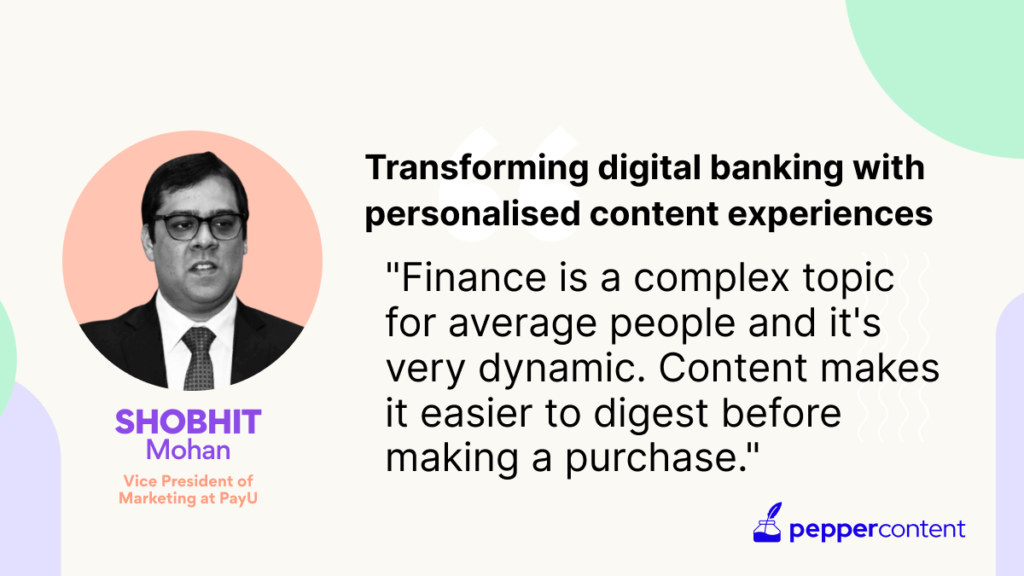Transforming Digital Banking with Personalized Content Experiences

Industries have been able to leverage the benefits of evolving technology, and the fintech space has undoubtedly claimed its significant share. If we talk about digitization, fintech, which is a broad term, has transformed dynamically in the recent past. Fintech is all about scale, and sectors like BFSI have witnessed many new users connecting to the digital world one way or another.
Decentralized financing is yet another dynamic aspect of digital banking that provides personalized content through a host of seamless services like inter-bank transfer of money. However, it requires massive capital to build technologies that regulate decentralized finance. Let’s dive deep into the scenario that paves the way for a personalized experience, with important contributions from Shobhit Mohan, Vice President-Marketing, PayU.

Catering to the Unbanked Ones
Fintech players in India witnessed a massive surge in business due to two significant events that unfolded recently in the country. Demonetization in 2016 and the COVID-19 pandemic since 2020.
However, a section of people is not yet acquainted with financial technology systems. There is a dire need to provide personalized services through digital banking, among other banking and financial services for people who are not as financially literate.
Therefore, fintech content should focus more on quality than quantity, which requires marketing to follow a similar notion. Position your content to offer people exactly what they are looking for.
Leveraging Machine Learning and AI
BFSI players were quick enough to switch gears and embrace the technological transition in the last five years. The entire fintech space has been designed to provide personalized content through various artificial intelligence products. It also paves the way for contextual-based advertising, digital marketing, and hyper-personalized workflows as the banking & finance world have a relatively broad base.
Personalized content becomes more accessible, supplemented by AI and machine learning. BFSI is undeniably exploring this space extensively to fulfill essential roles—refining customer service, using digital marketing tools that manage customer relationship management (CRM), etc.
Meeting Latent Demands
Traditional banking and finance service providers struggled to cater to customers’ latent demands, which startups like PayU and RazorPay endeavored to fulfill. Also, traditional players could not retain customer loyalty, which the new players seemingly had no difficulty gaining. Now, this is where technology and user experience play a substantial role, which the fintech players have been able to capitalize on quite efficiently.
Convenience and digital banking became prominent after players like Paytm took the lead and redefined the essence of personalized content. Eliminating the need to go to an ATM through a host of seamless services provided the necessary impetus fintech players needed to market their products. Hence, user acquisition along with user experience is significantly better. Furthermore, establishing channels to meet latent demands also enabled customers to stay loyal to such fintech players.
Content: The Best Salesperson for Banking & Finance
Financial services thrive on content regardless of their role in the industry, be it insurance agents, bank relationship managers, or salespeople. Content for fintech adopts a people-driven model, and financial companies like PolicyBazaar are considered the epitome of content creation.
Providing people with compelling insurance policies and facilitating them with reliable content sets Policy Bazaar apart from the crowd. Their marketing delivers a personalized experience, and it eventually comes down to carefully executed content creation. This principle is pervasive and has also been incorporated into digital banking and finance services.
Finance is a comprehensive industry that requires a decent understanding of the dynamics involved. For instance, a constant change in the regulations and products requires an immense amount of vital information to be analyzed and studied before making the final purchase. It is resolved by providing explicit content that acts as a bridge.
Walking in Tandem With the Regulations
Banking and finance companies operating in this fintech-saturated ecosystem should not view regulations as a deterrent. Instead, it is more of grabbing the opportunity to do the right thing at the right time. Regulatory authorities like SEBI, RBI, or any other governance system ensure the due protection of small and big players working towards content creation in the financial landscape.
Providing a personalized experience has to be legal and strictly adhere to the prescribed regulations to ensure survival in the long term. People susceptible to fraudsters or who succumb to malicious schemes usually consider regulations their haven. So, operating within the boundaries of the established rules and regulations is only an advantage because it deters miscreants from exploiting customers, businesses, etc.

Note: This blog is an excerpt from a session on Transforming Digital Banking with Personalised Content Experiences with Shobhit Mohan, Vice President-Marketing, PayU. The session was part of Elevate–a global virtual content summit organized by Pepper Content, bringing together industry leaders in content marketing.
Check out the video of the interview here.
Latest Blogs
Learn how to rank on AI search engines like ChatGPT, Perplexity, and Gemini by optimizing your content for authority, structure, and relevance. Stay ahead in AI-driven search with this strategic guide.
Explore the best healthcare SEO services for your medical practice. Improve online visibility and effectively reach more patients in need of your services.
Discover top social media agencies specializing in banking solutions, enhancing financial services and driving engagement.
Get your hands on the latest news!
Similar Posts

Content Marketing
4 mins read
11 Best B2B Content Marketing Agencies for B2B Companies in 2024

Content Marketing
5 mins read
Top ecommerce Marketing Agencies with Proven Strategies for 2024

Content Marketing
5 mins read